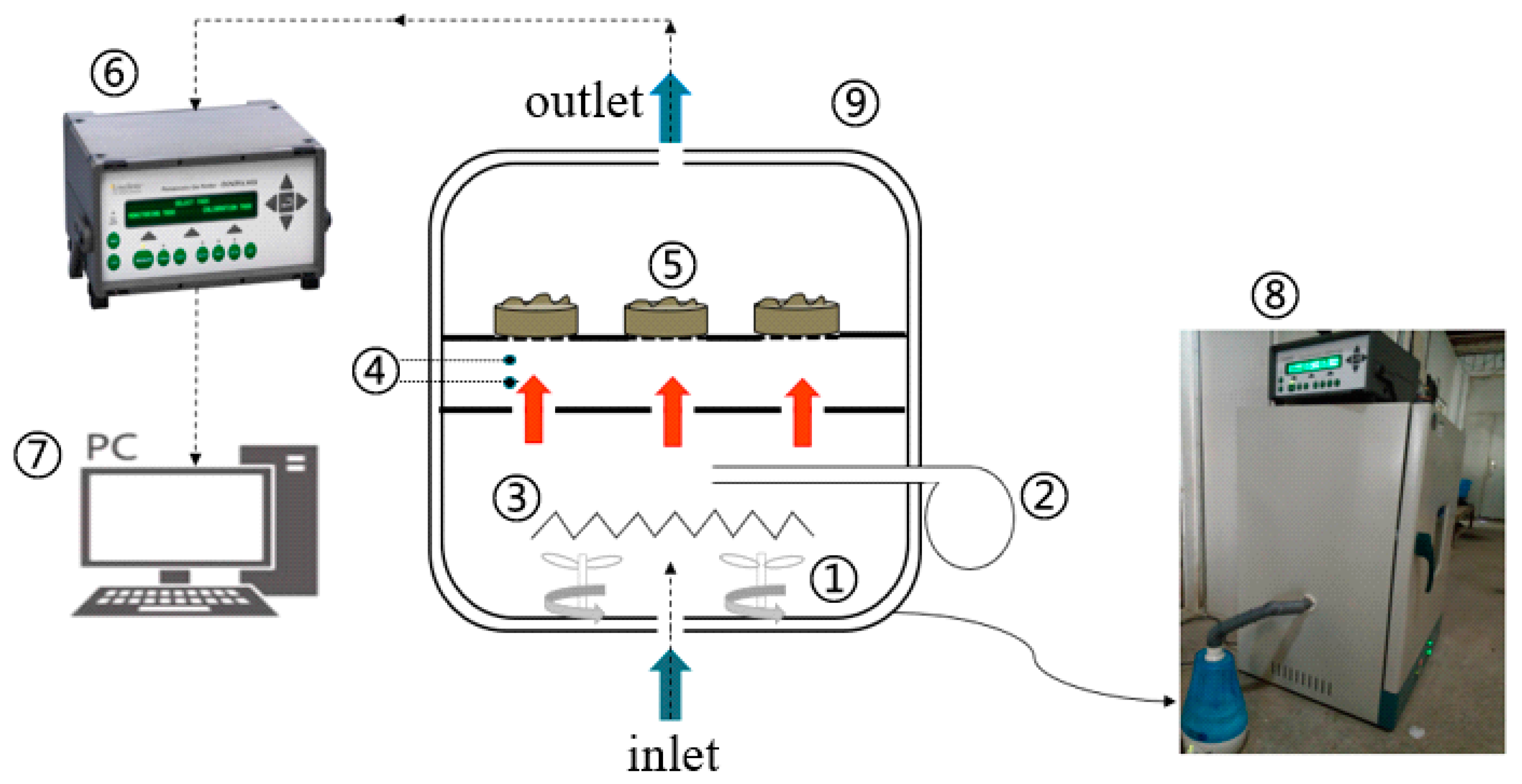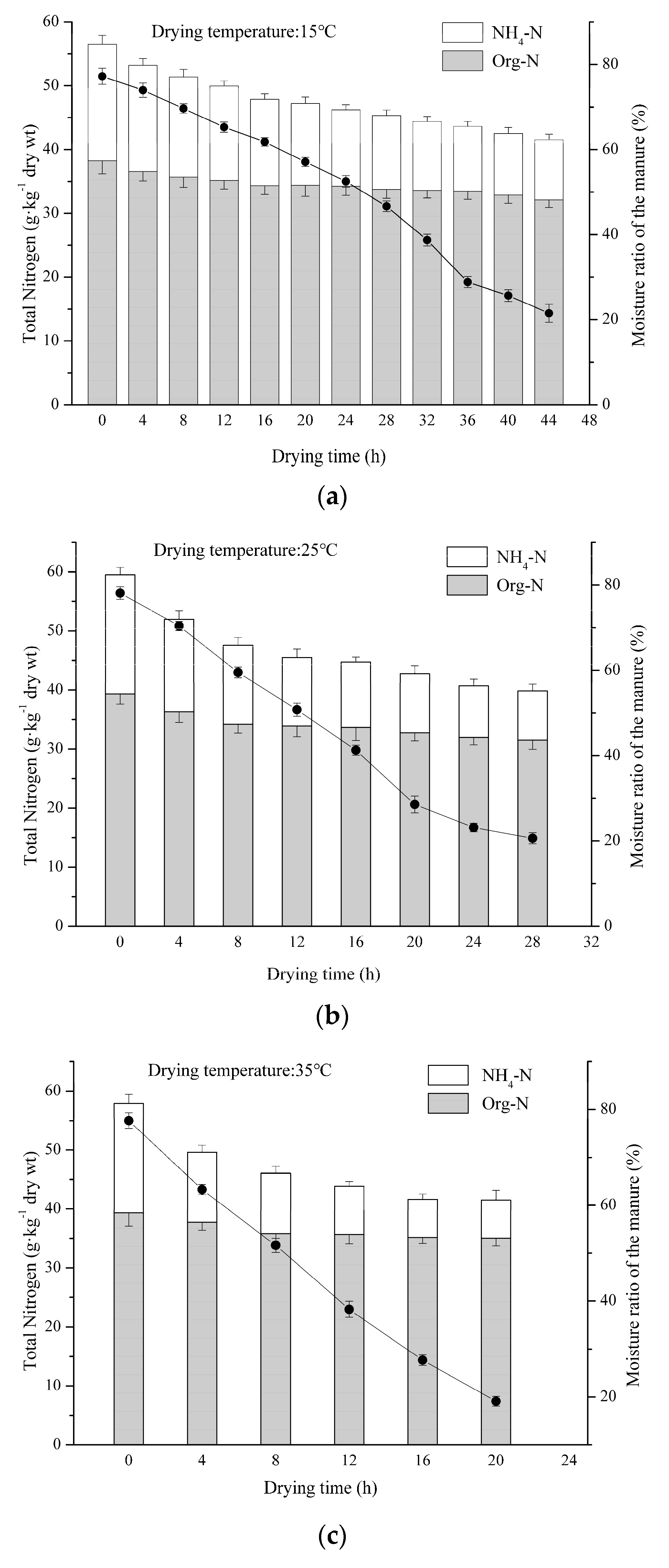The Effect of Drying Temperature on Nitrogen Loss and Pathogen Removal in Laying Hen Manure
Abstract
:1. Introduction
2. Materials and Methods
2.1. Laying Hen Manure Samples
2.2. Experimental Drying Apparatus
2.3. Experimental Analyses
2.4. Statistical Analysis
3. Results and Discussion
3.1. Manure Nitrogen Loss
3.2. Pathogen Removal
3.3. Energy Consumption
4. Conclusions
Author Contributions
Funding
Acknowledgments
Conflicts of Interest
References
- Ghaly, A.E.; Macdonald, K.N. Drying of poultry manure for use as animal feed. Am. J. Agric. Biol. Sci. 2012, 7, 239–254. [Google Scholar] [CrossRef] [Green Version]
- Timmer, B.; Olthuis, W.; Van Den Berg, A. Ammonia sensors and their applications—a review. Sens. Actuators B Chem. 2005, 107, 666–677. [Google Scholar] [CrossRef]
- Gay, S.W.; Schmidt, D.R.; Clanton, C.J.; Janni, K.A.; Jacobson, L.D.; Weisberg, S. Odor, total reduced sulfur, and ammonia emissions from animal housing facilities and manure storage units in Minnesota. Appl. Eng. Agric. 2003, 19, 347–360. [Google Scholar] [CrossRef]
- Ndegwa, P.M.; Hristov, A.N.; Arogo, J.; Sheffield, R.E. A review of ammonia emission mitigation techniques for concentrated animal feeding operations. Biosyst. Eng. 2008, 100, 453–469. [Google Scholar] [CrossRef]
- Chen, Z.; Jiang, X. Microbiological safety of chicken litter or chicken litter-based organic fertilizers: A review. Agriculture 2014, 4, 1–29. [Google Scholar] [CrossRef] [Green Version]
- Wilkinson, K.G.; Tee, E.; Tomkins, R.B.; Hepworth, G.; Premier, R. Effect of heating and aging of poultry litter on the persistence of enteric bacteria. Poult. Sci. 2011, 90, 10–18. [Google Scholar] [CrossRef]
- Kim, J.; Diao, J.S.; Shepherd, M.W.; Singh, R.; Heringa, S.D.; Gong, C.; Jiang, X.P. Validating Thermal Inactivation of Salmonella spp. in Fresh and Aged Chicken Litter. Appl. Environ. Microb. 2012, 78, 1302–1307. [Google Scholar] [CrossRef] [Green Version]
- Li, X.; Li, B.; Zheng, W.; Wang, Q.; Tong, Q. Drying performance of manure drying system with waste heat of poultry house in summer. Trans. Chin. Soc. Agric. Eng. 2019, 35, 188–194. [Google Scholar] [CrossRef]
- Li, X.; Zheng, W.; Li, B.; Tong, Q. Optimization of low-temperature drying of laying-hen manure using response surface methodology. J. Air Waste Manag. Assoc. 2019. just-accepted. [Google Scholar] [CrossRef]
- Rosa, E.; Arriaga, H.; Merino, P. Ammonia emission from a manure-belt laying hen facility equipped with an external manure drying tunnel. J. Clean. Prod. 2019, 251. [Google Scholar] [CrossRef]
- Santonja, G.G.; Georgitzikis, K.; Scalet, B.M.; Montobbio, P.; Roudier, S.; Sancho, L.D. Best Available Techniques (BAT) Reference Document for the Intensive 629 Rearing of Poultry or Pigs, 2017, Chapter 2. Available online: https://ec.europa.eu/jrc/en/publication/eur-scientific-and-technical-research-reports/best-available-techniques-bat-reference-document-intensive-rearing-poultry-or-pigs (accessed on 1 January 2020). [CrossRef]
- Koerkamp, P.G. Review on emissions of ammonia from housing systems for laying hens in relation to sources, processes, building design and manure handling. J. Agric. Eng. Res. 1994, 59, 73–87. [Google Scholar] [CrossRef]
- Winkel, A.; Mosquera, J.; Aarnink, A.J.A.; Koerkamp, P.W.G.G.; Ogink, N.W.M. Evaluation of manure drying tunnels to serve as dust filters in the exhaust of laying hen houses: Emissions of particulate matter, ammonia, and odour. Biosyst. Eng. 2017, 162, 81–98. [Google Scholar] [CrossRef]
- Aboltins, A.; Kic, P. Forced convection in drying of poultry manure. Agron. Res. 2015, 13, 215–222. [Google Scholar]
- Ghaly, A.E.; Macdonald, K.N. Kinetics of thin layer drying of poultry manure. Am. J. Biochem. Biotechnol. 2012, 8, 128–142. [Google Scholar] [CrossRef] [Green Version]
- Pagans, E.; Barrena, R.; Font, X.; Sanchez, A. Ammonia emissions from the composting of different organic wastes. Dependency on process temperature. Chemosphere 2006, 62, 1534–1542. [Google Scholar] [CrossRef] [PubMed] [Green Version]
- Pratt, E.V.; Rose, S.P.; Keeling, A.A. Effect of ambient temperature on losses of volatile nitrogen compounds from stored laying hen manure. Bioresour. Technol. 2002, 84, 203–205. [Google Scholar] [CrossRef]
- Nahm, K.H. Evaluation of the nitrogen content in poultry manure. World Poult. Sci. J. 2003, 59, 77–88. [Google Scholar] [CrossRef]
- Panetta, D.M.; Powers, W.J.; Lorimor, J.C. Management strategy impacts on ammonia volatilization from swine manure. J. Environ. Qual. 2005, 34, 1119–1130. [Google Scholar] [CrossRef]
- Ghaly, A.E.; Alhattab, M. Drying laying hen manure for pollution potential reduction and production of organic fertilizer. Am. J. Environ. Sci. 2013, 9, 88. [Google Scholar] [CrossRef] [Green Version]
- Horwitz, W. Official Methods of Analysis of AOAC International; William, H., Ed.; AOAC International: Gaithersburg, MD, USA, 1997; Volume I. [Google Scholar]
- Douglas, B.F.; Magdoff, F.R. An Evaluation of Nitrogen Mineralization Indices for Organic Residues. J. Environ. Qual. 1991, 20, 368–372. [Google Scholar] [CrossRef]
- Maier, R.M.; Pepper, I.L.; Gerba, C.P. Environmental Microbiology; Academic Press: Burlington, NJ, USA, 2000. [Google Scholar]
- Shaughnessy, S.A.; Song, I.; Artiola, J.F. Nitrogen loss during solar drying of biosolids. Environ. Technol. 2008, 29, 55–65. [Google Scholar] [CrossRef] [PubMed]
- Weast, R.C.; Astle, M.J.; Beyer, W.H. CRC Handbook of Chemistry and Physics; CRC Press: Boca Raton, FL, USA, 1988. [Google Scholar]
- Hadas, A.; Baryosef, B.; Davidov, S.; Sofer, M. Effect of Pelleting, Temperature, and Soil Type on Mineral Nitrogen Release from Poultry and Dairy Manures. Soil Sci. Soc. Am. J. 1983, 47, 1129–1133. [Google Scholar] [CrossRef]
- U.S. Environmental Protection Agency. Standards for Use and Disposal of Sewage Sludge. In Code of Federal Regulations; U.S. Environmental Protection Agency: Washington, DC, USA, 1993; Volume 503, p. 40. [Google Scholar]
- Turner, C. The thermal inactivation of E-coli in straw and pig manure. Bioresour. Technol. 2002, 84, 57–61. [Google Scholar] [CrossRef]
- Islam, M.; Doyle, M.P.; Phatak, S.C.; Millner, P.; Jiang, X. Survival of Escherichia coli O157: H7 in soil and on carrots and onions grown in fields treated with contaminated manure composts or irrigation water. Food Microbial. 2005, 22, 63–70. [Google Scholar] [CrossRef]
- Islam, M.; Doyle, M.P.; Phatak, S.C.; Millner, P.; Jiang, X. Persistence of enterohemorrhagic Escherichia coli O157: H7 in soil and on leaf lettuce and parsley grown in fields treated with contaminated manure composts or irrigation water. J. Food Prot. 2004, 67, 1365–1370. [Google Scholar] [CrossRef] [Green Version]
- Motevali, A.; Minaei, S.; Khoshtagaza, M.H. Evaluation of energy consumption in different drying methods. Energy Convers. Manag. 2011, 52, 1192–1199. [Google Scholar] [CrossRef]
- Lianbai, G. Recent research and development in wood drying technologies in China. Dry. Technol. 2007, 25, 463–469. [Google Scholar] [CrossRef]




| Manure Properties | Bird Age, Week | ||
|---|---|---|---|
| 53 | 54 | 55 | |
| TKN, g·kg−1 | 55.19 ± 1.79 | 57.37 ± 1.80 | 56.53 ± 1.95 |
| Org-N, g·kg−1 | 37.21 ± 2.01 | 38.05 ± 2.02 | 38.48 ± 2.20 |
| NH4-N, g·kg−1 | 17.98 ± 1.36 | 19.32 ± 1.44 | 18.05 ± 1.21 |
| Moisture, % | 74.8 ± 1.7 | 77.0 ± 3.4 | 76.4 ± 1.2 |
| pH | 8.2 ± 0.2 | 8.1 ± 0.3 | 8.2 ± 0.2 |
© 2020 by the authors. Licensee MDPI, Basel, Switzerland. This article is an open access article distributed under the terms and conditions of the Creative Commons Attribution (CC BY) license (http://creativecommons.org/licenses/by/4.0/).
Share and Cite
Li, X.; Li, B.; Tong, Q. The Effect of Drying Temperature on Nitrogen Loss and Pathogen Removal in Laying Hen Manure. Sustainability 2020, 12, 403. https://doi.org/10.3390/su12010403
Li X, Li B, Tong Q. The Effect of Drying Temperature on Nitrogen Loss and Pathogen Removal in Laying Hen Manure. Sustainability. 2020; 12(1):403. https://doi.org/10.3390/su12010403
Chicago/Turabian StyleLi, Xuanyang, Baoming Li, and Qin Tong. 2020. "The Effect of Drying Temperature on Nitrogen Loss and Pathogen Removal in Laying Hen Manure" Sustainability 12, no. 1: 403. https://doi.org/10.3390/su12010403
APA StyleLi, X., Li, B., & Tong, Q. (2020). The Effect of Drying Temperature on Nitrogen Loss and Pathogen Removal in Laying Hen Manure. Sustainability, 12(1), 403. https://doi.org/10.3390/su12010403





